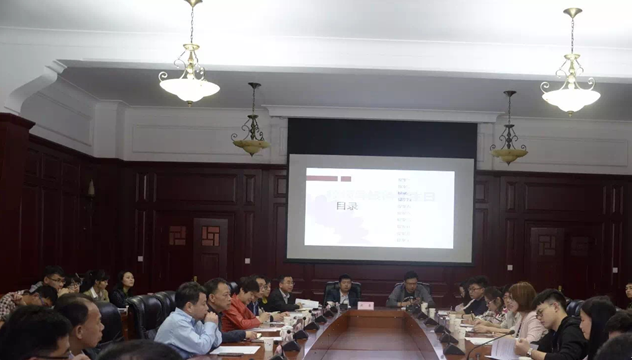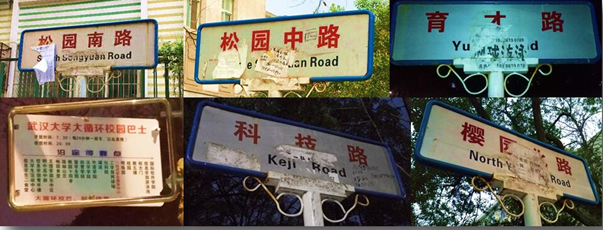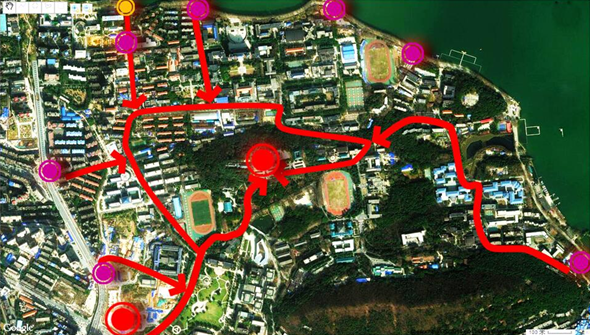On April 20th, the WHU Leadership Reception was held in the Administration Building. Vice-President Li Fei and staff representatives from the WHU Office of Security, Office of Logistics Service, Office of Publicity and so on attended the meeting. The WHU School Leadership Reception, which has a history of more than four years, was launched to solve present problems on campus by opening up communication between the university and its students. On the day of the reception, student representatives will offer constructive proposals on issues covering campus environment, student cultivation and dormitory-related problems.

School leaders and student representatives discussing campus problems
What made this week’s reception special was that the student representatives were actually winners of the first Campus Proposal Competition. “Normally Association of Student Rights and Interest (a department of WHU Students’ Union) would serve as the information deliverer, collecting feedback from students and sending them to relevant offices. But this time, we’ve decided to give the opportunity back to the students themselves by holding the Campus Proposal Competition to select the best and most needed proposals,” said Guo Zhuang, vice-director of the Association of Student Rights and Interest. According to Guo, the competition has attracted over sixty teams from different schools and colleges came to participate and submitted their proposals. After two rounds of presentations and voting, ten teams won themselves the opportunity to present their proposals at the reception conference.
Wang Junli, leader of the champion “Guihua Team”, expressed her gratitude towards this competition. “It was the first time for one of my ideas to gain the attention of the school leaders. Undoubtedly it was the best reward for my three-year devotion to the School of Urban Design, which was also the main driving force behind my participation,” said Wang. Their proposal dealt with the issue of guideboards in WHU, including unifying guideboard styles in every district, adding new guideboards pointing out school gates for tourists and visitors, increasing guideboards at crossroads with QR (Quick Response) codes that provide voice prompt and guides to places of accommodation. Corresponding to the new guideboard system, the main buildings on campus should also have their own “name cards”.
“Our inspiration came from daily life. The campus of WHU is so large that people could easily get lost. Students easily get lost on their way to teaching buildings and visitors cannot find directions during the cherry blossom season. Even some taxi drivers are not willing to enter the school because of the complex road systems,” explained Wang Junli. Therefore, she and the other six team members decided to apply their professional knowledge to solve the problem. They did a lot of research about the guideboards on campus: taking photos, drawing node network diagrams and analyzing car routes. Through their research, they found that there were few guideboards for cars and many of them were not clear enough. Some guideboards were damaged by graffiti and flyer postings. Hence, Wang and her team focused their work mainly on three aspects: researching on the current situation of guideboards, proposing a systematic way to repair them, and integrating campus features into their designs.

Some guideboards are damaged by random graffiti and flyer postings

Car routes during the Cherry Blossom Festival, drawn by the “GUIHUA (planning)” team
On the day of the reception, Wang’s team had a detailed discussion with the school office. The Office of Publicity explained that the roads on campus witnessed several instances of re-planning and re-naming. Current guideboards were set up at different times, thus leading to the chaos. In addition, given the complicated layout of the campus, adding large-sized guideboards were not suitable, but smaller ones could be taken in consideration. Li Fei, the vice-president, agreed that it was a realistic problem. He also mentioned that the English name of some roads were not standard either, which demanded further editing. The more complicated the roads are, the more necessary it is for WHU to establish a complete and accurate guideboard system.
The proposal by Wang’s team was welcomed by the staff. The quick and direct reply from school leaders was beyond Wang Junli’s expectation. As for putting their idea into practice, she said that a professional design team was in need and support from the school was essential. Most importantly, they should take steps to deal with the problem from an integrative perspective.
The first Campus Proposal Competition and the School Leadership Reception created an opportunity for every individual to make contributions to our big family. As for the future, Guo Zhuang, one of the event organizers, assumed that they could provide more of these opportunities to students and encourage them to hone a broader perspective, making proposals not only limited to constructions, dorms and so on.
University leaders were also impressed by this reception. As Vice-President Li Fei concluded, proposals from students were becoming more and more far-sighted, which reflected their increasing care for the university. WHU will cherish every proposal from its students. With the joint effort of staff and students, a better WHU will be realized.
(Photo by Quanxinquanyi and Wang Junli, edited by Tang Yedan, Wu Siying, Edmund Wai Man Lai & Hu Sijia)